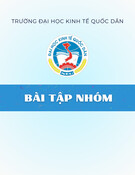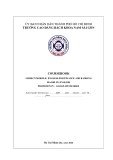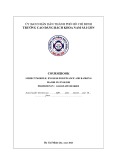
VĂN HÓA https://jst-haui.vn Tạp chí Khoa học và Công nghệ Trường Đại học Công nghiệp Hà Nội Tập 60 - Số 12 (12/2024)
106
NGÔN NG
Ữ
P
-
ISSN 1859
-
3585
E
-
ISSN
2615
-
961
9
AN SFG ANALYSIS OF MODALITY IN ENGLISH JOURNAL ARTICLES ON FINANCE
PHÂN TÍCH TÌNH THÁI TRONG BÀI BÁO CHUYÊN NGÀNH TÀI CHÍNH TIẾNG ANH THEO QUAN ĐIỂM NGỮ PHÁP CHỨC NĂNG HỆ THỐNG Nguyen Thi Thanh Hoa1,* DOI: http://doi.org/10.57001/huih5804.2024.424 1. INTRODUCTION In recent years, training in academic writing has not been regarded as an official or compulsory course. Furthermore, comprehensive theoretical and practical knowledge still reserves a research gap despite some limited discussions on academic writing characteristics in scientific works, for example, Dinh Trong Lac [3], Dinh Trong Lac and Nguyen Thai Hoa [4], Tran Ngoc Them [17]. In some other doctoral theses, authors focus on a small number of aspects of academic writing, e.g doctoral dissertation by Nguyen Thi Huyen Trang [12] contrasting means hedging in Vietnamese and English academic writing, the article by Nguyen Thi Minh Tam and Ngo Huu Hoang [13] on structures on abstracts in English and Vietnamese journal articles and another work by Lam Quang Dong [11] on the language use of Vietnamese academic writing. Regarding linguistic characteristics in journal articles in English, certain doctoral papers cover this field, naming features of pharmaceutical texts in English and Vietnamese by Vo Thi Be [18], linguistic features of museum texts in Vietnamese and English from a system functional perspective (2018), experiential ABSTRACT Using modality in scientific discourses is of great interest to writers. Therefore,
there is an
essential need to
study modality use in journal articles on finance. This paper aims to analyze
linguistic features of modality used in English journal articles
from Systemic Functional Grammar
perspective
to enhance global benchmarks in international publications to convey communicative
functions between writers and readers effectively.
This paper aims to analyze journal articles in
English to enhance global benchmarks in international publications.
50 articles randomly chosen
from 10 Scopus-indexed journals on finance and finance-
related fields published in English are
analyzed to
answer the following specific questions: (1) what types of modality are used in English
journal
articles on finance?, and (2) what are they used for? This knowledge of modality
and their
functions in English journal articles on finance will help Vietnamese authors improve the
quality of
their articles for international publication. Keywords: SFG, modality, journal articles, finance. TÓM TẮT Sử dụng thức trong các diễn ngôn khoa học thu hút sự quan tâm của các độc giả. Do đó, việ
c
nghiên cứu cách sử dụng thức trong các bài báo tạp chí tài chính trở thành một yêu cầu cần thiế
t.
Bài báo nhằm phân tích đặc điểm ngôn ngữ của việc sử dụng thức trong các bài báo tạ
p chí tài chính
được viết bằng tiếng Anh từ góc độ ngữ pháp chức năng hệ thống với mục đích nâng cao tiêu chuẩ
n
viết bài trong các ấn phẩm quốc tế. Số lượng 50 bài báo tiếng Anh được chọn ngẫu nhiên từ 10 tạ
p
chí trong dữ liệu Scopus về tài chính và các lĩnh vực liên quan đến tài chính được phân tích nhằ
m
trả lời các câu hỏi cụ thể sau: (1) những kiểu tình thái nào được sử dụng trong các bài báo tạ
p chí
tài chính tiếng Anh? (2) các kiểu tình thái này được dùng để làm gì? Những hiểu biết cần thiết vềcác kiểu tình thái và chức năng của chúng trong các bài báo tạp chí tài chính tiếng Anh sẽ
giúp các
tác giả nâng cao chất lượng bài báo của mình để xuất bản quốc tế. Từ khóa: Ngữ pháp chức năng hê thống, tình thái, bài báo tạp chí, tài chính 1Hanoi University of Mining and Geology, Vietnam *Email: nguyenthithanhhoa@humg.edu.vn Received: 04/11/2024 Revised: 16/12/2024 Accepted: 26/12/2024

P-ISSN 1859-3585 E-ISSN 2615-9619 https://jst-haui.vn LANGUAGE - CULTURE Vol. 60 - No. 12 (Dec 2024) HaUI Journal of Science and Technology
107
meanings in English and Vietnamese specialised economics journal articles: a transitivity comparison (2020) and language of law in Vietnamese in comparison with English and applications in Vietnamese-English Translation by Le Hung Tien. Given the current push for Vietnamese scholars to publish their work internationally, the questions that need to be asked right now include how to write better for academic purposes, and what common international benchmarks for journal articles they must pay attention to. Answering these questions is necessary for the study, and the analysis in this paper from Systemic Functional Grammar (SFG) perspective lies in one of such attempts, which raises the following research questions: (1) what types of modality are used in English journal articles on finance?, and (2) what are they used for? 2. LITERATURE REVIEW 2.1. Systemic Functional Grammar Systemic Functional Grammar is a development of detailed system networks with functions of language, a resource that man can narrow the meanings which speakers/ writers mean from the context of culture to specific situations using extra linguistics factors, namely FIELD, TENOR, MODE to do the three main meta functions: ideational, a theory of human experience, and certain of the resources of the resources of lexicogrammar of every language are dedicated to that function. While being used, language also enacts our personal and social relationships with the other people around us. The so-called clauses represent the process - some doing or happening, saying or sensing, being or having - with its various participants and circumstances, for which we consider language to act on ideational function; the mode, whereby we inform or question, give an order or make an offer, and modality when we express our appraisal of and attitude towards whoever we are addressing and what we are talking about, for which we call it interpersonal function. In a sense, clauses can be regarded as an enabling or facilitating function to construct discourse sequences, organizing discussive flow and creating cohesion and coherence as they move along. In this case language acts on textual function. 2.2. Modality Modality refers to intermediate degrees, between the positive and negative poles. What the modality does is to construe the area of uncertainty that lies between “yes” and “no”. According to Halliday, modality consists of particular types such as possibility, probability, frequency, obligation, etc. Due to the research’s scope, the paper aims to investigate the two main kinds, naming Modalization regarding probabiltity/ possibility and Modulation regarding obligation. Modalization and Modulation can be expressed by such finite modal verb operators in the verbal group with degrees of low, median and high. The following modal verb operators illustrate this degree. Modality
Low Median High Positive can, may, could, might will, would, should, is/was to must, ought to, need, has/had to
Negative
can’t, may not, couldn’t, might not
won’t, wouldn’t, shouldn’t, isn’t/wasn’t to musn’t, oughtn’t to, can’t, couldn’t, mightn’t, hasn’t/ hadn’t to In this paper, modality classifications are used to deal with the research questions. In Vietnam, modality has been analyzed in some studies regarding the linguistic features of medical journal [18] or museum texts [15], experiential meaning meanings in English journal articles on economics [14]. Yet, journal articles on finance have not been investigated, both in English and Vietnamese. Therefore, this study aims to fill out this gap with some preliminary findings partially. 3. METHODOLOGY 3.1. Sampling and Data Collection English journal articles on finance covering various financial topics, including corporate finance, taxation, import and export, etc., provided the data for this study. The selected journal articles are included in famous indexes such as the Journal of Corporate Finance, the Journal of Banking & Finance, the International Review of Financial Analysis, and the Review of Finance. The 50 journal papers selected for this study's data were confined to the most recent releases until the study began. 1,324 clauses are investigated to identify their types of modality, and their functions, and the analytical unit was the clause. 3.2. Data Analysis Statistical techniques are employed to ascertain the quantity and regularity of each modality type in English journal articles on finance that cover modalization and

VĂN HÓA https://jst-haui.vn Tạp chí Khoa học và Công nghệ Trường Đại học Công nghiệp Hà Nội Tập 60 - Số 12 (12/2024)
108
NGÔN NG
Ữ
P
-
ISSN 1859
-
3585
E
-
ISSN
2615
-
961
9
modulation. As a result, the exceptional findings highlight fundamental linguistic traits and attributes. Additionally, in English journal papers on finance, remarkable language elements of modality types are identified through description, analysis, synthesis, and generalization. 4. FINDINGS The study results are found through the analysis of Halliday'systemic functional grammar framework. They indicate that English journal articles on finance use the two main types of modality as shown in Table 1. Table 1. Distribution of Modality Types in English Journal Articles on Finance No. Modality Types Number Percentage 1 Modalization 202/1,324 15.3 % 2 Modulation 12/1,324 0.9% As can be seen, modalization occurs with a higher percentage, accounting for 15.3% (202/1,324), whereas modulation accounts for 0.9% (12/1,324) respectively. English journal articles on finance belong to the scientific genre which uses modalization to express the possibily or probability of events and modulation to propose recommendations or solution to leaders or policy makers in finance for taking the responsibility for dealing with financial issues. Modality in English journal articles is formularised as: Subject-Finite-Residue. Modalization in English journal articles is illustrated with may/can in the instances as follows: (1) Such imprecision (Subject) may (Finite) explain the releconomic systems, geography, technology, macro economic policies, micro-economic behavior, social narratives (Residue). Such imprecision is the subject of the clause and explain the releconomic systems, geography, technology, macro economic policies, micro-economic behavior, social narratives is the subject’s prediction with the use of modal verb “may”. (2) One potential application of the analyzed soft information is to help banks improve their credit-risk assessment, particularly their qualitative assessment approach. Morever, prationers such as fund managers (Subject) can (Finite) utilize the learned high-risk sentiment key- words to assisst in designing their own investment strategies (Residue). Practioners such as fund managers is the subject of the clause and utilize the learned highrisk sentiment key-words to assisst in designing their own investment strategies is the subject’s prediction with the use of modal verb “can”. (3) For accounting research also, understanding the soft information in financial reports is a vital task, because the soft information (Subject) can (Finite) provide a very helpful context for understanding financial data and testing interesting economic hypotheses (Residue). Soft information is the subject of the clause and provide a very helpful context for understanding financial data and testing interesting economic hypotheses is the subject’s prediction with the use of modal verb “can” (4) The financial services offered by the Slow Money Alliance concern companies’ full balance sheets. Local Slow Money Alliance groups (Subject) can (Finite) consequently provide short-term loans (Residue), by means of online crowdfunding platforms. Local Slow Money Alliance groups is the subject of the clause and provide short-term loans strategies is the subject’s prediction with the use of modal verb “can”. The linguistic component analysis in the above examples shows that modalization is used in English journal articles to reflect interpersonal meaning with the use of modal verbs indicating possibility or probability such as can/could/may/might, etc which are given by the author to bring about anticipation or conclusions inferred from research results. Modulation in English journal articles on finance is illustrated with need/ should in the examples as follows: (5) However, financial theory places the burden of deleveraging uniquely on the debtors’ side, and does not acknowledge the responsibility of creditors. We (Subject) thus need to (Finite) interrogate the moral framework by which we understand the institution of debt (Residue). We is the subject of the clause and interrogate the moral framework by which we understand the institution of debt is the solutions which need being resolved with the use of modal verb “need to”. (6) Neoclassical investment tools, however, seem to suit the human capital needs of academics and researchers who stick with irrelevant theory even though they (Subject) should be actively (Finite) searching for a new set of tools (Residue). Personal pronoun “they” replaces academics and researchers which is the subject of the clause and searching for a new set of tools is solution which need to be solved with the use of modal verb “should”. The stated linguistic components analysis reveal that the use of modal verbs illustrates modulation in English

P-ISSN 1859-3585 E-ISSN 2615-9619 https://jst-haui.vn LANGUAGE - CULTURE Vol. 60 - No. 12 (Dec 2024) HaUI Journal of Science and Technology
109
journal articles on finance “need to, should…” in order to show the obligation and responsibility, carrying interpersonal meaning in the communication community with the aim of showing obligation and commitment of leaders and policy makers in looking into resolutions and policies in financial sector. 5. DISCUSSION The findings clearly show that modalization and modulation reflect interpersonal meaning in English journal articles on finance. Regarding modalization, authors focus on descriptions and analyses of prediction in financial issues. With regard to modulation, authors tend to use modal verbs to present their viewpoints on the obligation and responsibilities that leaders and policy makers need to do in handling financial matters. The analysis in the study also demonstrates to Vietnamese authors the importance of proper use of modality for particular linguistic functions expressed by modal verb operators. 6. CONCLUSION After analyzing a sizable number of clauses from 50 finance-related journal articles from a functional perspective, this study identifies distinct kinds of modality and how they are used to convey various functions. These partially contribute to the linguistic requirements that writers of academic journal articles, including those in the finance field, should comply with. Therefore, to meet international standards and have more of their valuable works published internationally, Vietnamese scholars and researchers in this field will benefit greatly from the study by having a better understanding of these linguistic requirements and selecting the appropriate language for their articles. REFERENCES [1]. Diệp Q.B., Giao tiếp - Văn bản - Mạch lạc - Liên kết - Đoạn văn (Communication - Text - Cohesion - Coherence - Paragraph). NXB Khoa học Xã hội, 2002. [2]. Diệp Q.B., Văn bản và liên kết trong tiếng Việt (Texts and Cohesion in Vietnamese). NXB Giáo dục, 2005. [3]. Đinh T.L., Phong cách học tiếng Việt (Vietnamese stylistics). NXB Giáo dục, 1994. [4]. Đinh T.L., Nguyễn T.H, Phong cách học tiếng Việt (Vietnamese stylistics). NXB Giáo dục, 1993. [5]. Eggins S., An introduction to systemic functional linguistics (2nd ed). Continuum, 2004. [6]. Halliday M.A.K, An introduction to functional grammar. Rouledge, Taylor & Francis Group, 1994. [7]. Halliday M.A.K., Mathiessen C.M.I., An introduction to functional grammar. Rouledge, 2004. [8]. Hội đồng chức danh Giáo sư Nhà nước, Công văn số 37/HĐCDGSNN ngày 04 tháng 4 năm 2016 về yêu cầu về chất lượng khoa học và thể thức đăng bài trong các tạp chí khoa học được tính điểm. Hà Nội, 2016. [9]. Hữu Đ., Phong cách học tiếng Việt hiện đại (Modern Vietnamese stylistics). NXB Giáo dục Việt Nam, 2010. [10]. Kress G., Hodge R., Language as ideology. Rouledge & Kegan Paul, 1979. [11]. Lâm Q. Đ., “Đánh giá ngôn ngữ trong văn bản khoa học tiếng Việt: Kết quả bước đầu,” Tạp chí Ngôn ngữ và Đời sống, 261 (7), 3-14, 2017 [12]. Nguyen T.H.T., A contrastive analysis of hedging in Vietnamese and English academic writing. Doctoral disertation, Graduate Academy of Social Sciences, Vietnam Academy of Social Sciences, 2018. [13]. Nguyen T.M.T, Ngo H.H., “Investigating the generic structure potential of English and Vietnamese journal article abstracts in the light of systemic functional linguistics,” In University of Foreign Language Studies, The University of Danang (Eds), National Conference on researching and teaching the native language, foreign languages and area studies in the integration period (pp.243-248). Da Nang Publishing House, 2017. [14]. Nguyen T. P. L., Experiential meanings in English and Vietnamese speacialised economics journal articles: A transitivity comparison, Doctoral dissertation, VNU University of Languages and International Studies. 2021. http://repository.vnu.edu.vn/handle/VNU_123/137491. [15]. Nguyen T. Q. H., Characteritics of museum texts in Vietnamese and English in terms of transitivity. Doctoral dissertation, Graduate Academy of Social Sciences, Vietnam Academy of Social Sciences, 2017. [16]. Nguyen T. T. H., Analysis of lexical collocations errors in essays committed by double-majored students at Hanoi National University of Education. VNU Journal of Social Sciences and Humanities, 6(2),281-289, 2020. http://dx.doi.org/10.1172/vjossh.v6i2.550. [17]. Trần N.T., Hệ thống liên kết văn bản tiếng Việt. NXB Giáo dục, 1999. [18]. Vo T.B., Linguistics features of English for Pharmacology in contrast with Vietnamese. Doctoral dissertation, Graduate Academy of Social Sciences, Vietnam Academy of Social Sciences, 2019. [19]. Vu T.K.L., Error in Vietnamese-English collocation translation made by students at the University of Languages and International Studies (ULIS). Bachelor thesis, VNU University of Languages and International Studies, 2013. http://repository.vnu.edu.vn/handle/VNU_123/100019. THÔNG TIN TÁC GIẢ Nguyễn Thị Thanh Hoà Trường Đại học Mỏ - Địa chất






![Bài tập thì hiện tại hoàn thành [kèm đáp án chi tiết]](https://cdn.tailieu.vn/images/document/thumbnail/2025/20251106/thuthao27062004/135x160/41601762420911.jpg)






![Tài liệu ôn tập Ngữ pháp tiếng Anh [chuẩn/mới nhất/tổng hợp]](https://cdn.tailieu.vn/images/document/thumbnail/2025/20250821/vuongdinhlinh1412@gmail.com/135x160/933_tai-lieu-on-tap-ngu-phap-tieng-anh.jpg)




